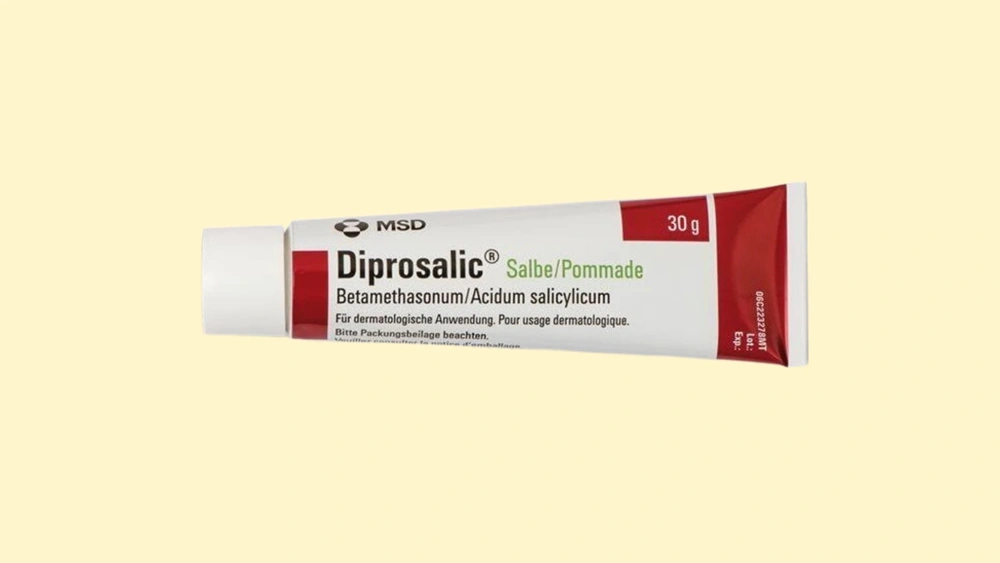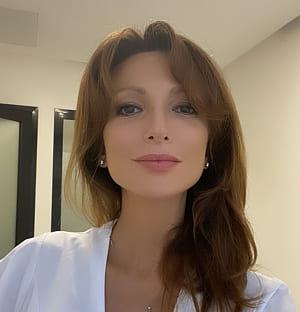

Diprosalic

Ask a doctor about a prescription for Diprosalic

How to use Diprosalic
Package Leaflet: Information for the Patient
Warning! Keep the leaflet! Information on the immediate packaging in a foreign language.
Diprosalic(Diprosalic Ointment), (0.64 mg + 30 mg)/g, ointment
Betamethasone dipropionate+ Salicylic acid
Diprosalic and Diprosalic Ointment are different trade names for the same medicine.
Read the leaflet carefully before using the medicine, as it contains important information for the patient.
- Keep this leaflet, so you can read it again if you need to.
- If you have any doubts, consult a doctor or pharmacist.
- This medicine has been prescribed specifically for you. Do not pass it on to others. The medicine may harm another person, even if their symptoms are the same.
- If the patient experiences any side effects, including any side effects not listed in this leaflet, they should tell their doctor or pharmacist. See section 4.
Table of Contents of the Leaflet
- 1. What is Diprosalic and what is it used for
- 2. Important information before using Diprosalic
- 3. How to use Diprosalic
- 4. Possible side effects
- 5. How to store Diprosalic
- 6. Contents of the pack and other information
1. What is Diprosalic and what is it used for
Diprosalic ointment contains the active substances: betamethasone dipropionate and salicylic acid.
Betamethasone dipropionate is a synthetic fluorinated corticosteroid with strong action;
used topically, it has anti-inflammatory and antipruritic effects, as well as vasoconstrictive effects.
Salicylic acid, used topically, softens keratin and thickened skin and exfoliates the skin, facilitating the penetration of betamethasone dipropionate into the skin.
Indications
Diprosalic is indicated for the topical treatment of acute and chronic skin diseases, such as: psoriasis, severe forms of atopic dermatitis, limited neurodermatitis, lichen planus, severe forms of eczema (including nummular eczema and contact eczema).
2. Important information before using Diprosalic
When not to use Diprosalic:
- if the patient is allergic to betamethasone dipropionate and salicylic acid or any of the other ingredients of this medicine (listed in section 6);
- in the case of bacterial infections (e.g., tuberculosis, scrofula), viral (herpes, shingles, chickenpox) or fungal skin infections;
- in common acne;
- in rosacea;
- in perioral dermatitis;
- on facial skin;
- in diaper dermatitis;
- in pruritus of the anal and genital areas;
- in children under 12 years of age.
Warnings and precautions
Before starting to use Diprosalic, discuss it with your doctor or pharmacist.
Avoid using the medicine on a large area of the body, especially in children.
If symptoms of irritation, allergy, or excessive skin dryness occur during the use of Diprosalic, stop using the medicine and consult a doctor.
If bacterial infections occur, the doctor will prescribe appropriate antibacterial treatment.
During the use of the medicine, side effects similar to those that occur with the use of systemic corticosteroids may occur, including adrenal insufficiency. Therefore, avoid using the medicine on a large area of skin, wounds, damaged skin, using the medicine in large doses, and long-term use.
In case of necessity to use the medicine in such cases, special precautions should be taken.
Particular caution should be exercised when using the medicine in psoriasis. The use of the medicine in psoriasis may cause a relapse of the disease due to the development of tolerance, the occurrence of generalized pustular psoriasis, and general toxic effects related to skin continuity disorders.
The medicine should not be used under occlusive dressings, as it may increase the percutaneous absorption of the corticosteroid.
Do not use in the eyes.
Avoid contact of the medicine with the eyes and mucous membranes.
Use with caution in children. In children, it is easier than in adults to cause inhibition of the hypothalamic-pituitary-adrenal axis and the occurrence of side effects characteristic of corticosteroids.
In children treated with topical corticosteroids, inhibition of the hypothalamic-pituitary-adrenal axis, Cushing's syndrome, growth retardation, decreased body weight gain, and intracranial hypertension have been reported.
If the patient experiences blurred vision or other visual disturbances, they should consult a doctor.
Children
Do not use in children under 12 years of age.
Diprosalic and other medicines
No data available.
Tell your doctor or pharmacist about all medicines you are taking, have recently taken, or plan to take.
Pregnancy and breastfeeding
If you are pregnant or breastfeeding, think you may be pregnant, or plan to have a child, consult your doctor or pharmacist before using this medicine.
No data are available on the topical use of corticosteroids in pregnant women. Diprosalic can be used only when the potential benefit to the mother outweighs the possible risk to the fetus.
It is not known whether topically applied corticosteroids pass into breast milk. A decision should be made to either discontinue breastfeeding or discontinue Diprosalic, taking into account the benefit of breastfeeding to the child and the benefit of treatment to the mother.
Driving and using machines
Diprosalic has no effect on the ability to drive and use machines.
3. How to use Diprosalic
This medicine should always be used as directed by your doctor. If you are unsure, consult your doctor or pharmacist.
This medicine is for use on the skin.
Adults and children over 12 years of age
Usually, a small amount of the medicine (0.2-0.5 cm of ointment per 10 cm of skin surface) is applied to the affected areas of the skin and gently rubbed in twice a day (morning and evening).
In some cases, the doctor may recommend less frequent use of the medicine. Treatment should not last longer than 14 days. If the disease relapses, the doctor will consider whether the treatment can be repeated.
Do not use the medicine in children under 12 years of age.
If you feel that the effect of Diprosalic is too strong or too weak, consult your doctor.
Using a higher dose of Diprosalic than recommended
Long-term use of the medicine may lead to inhibition of the hypothalamic-pituitary-adrenal axis and, consequently, to secondary adrenal insufficiency, as well as to hypercorticism, including Cushing's syndrome.
Additionally, long-term or high-dose use of the medicine may cause salicylic acid poisoning.
In case of overdose, the doctor will provide appropriate symptomatic treatment.
Acute symptoms of corticosteroid overdose are usually reversible. If necessary, the doctor will correct the electrolyte balance and, in the case of chronic poisoning, will recommend gradual, gradual withdrawal of the medicine.
In the case of salicylic acid poisoning, the doctor will take actions to quickly remove salicylates from the patient's body.
Missing a dose of Diprosalic
Do not use a double dose to make up for a missed dose.
4. Possible side effects
Like all medicines, this medicine can cause side effects, although not everybody gets them.
During the use of Diprosalic, the following side effects may occur: burning, itching, irritation, skin dryness, folliculitis, hypertrichosis, acne-like changes, skin depigmentation, perioral dermatitis, allergic contact dermatitis, skin maceration, secondary infections, skin atrophy, striae, and furuncles.
Due to the fact that the medicine contains salicylic acid, skin inflammation may occur during long-term use.
As a result of the absorption of the active substances into the blood, general side effects of betamethasone (characteristic of corticosteroids) and salicylic acid may also occur.
General side effects occur mainly in the case of long-term use of the medicine, use on a large area of skin, and use in children.
During the use of corticosteroids, blurred vision (frequency not known - cannot be determined based on available data) has been observed.
Reporting side effects
If you experience any side effects, including any side effects not listed in this leaflet, tell your doctor or pharmacist. Side effects can be reported directly to the Department of Monitoring of Adverse Reactions to Medicinal Products, Office for Registration of Medicinal Products, Medical Devices, and Biocidal Products, Al. Jerozolimskie 181C, 02-222 Warsaw, tel.: +48 22 49 21 301, fax: +48 22 49 21 309, website: https://smz.ezdrowie.gov.pl.
By reporting side effects, you can help gather more information on the safety of the medicine.
5. How to store Diprosalic
Store below 25°C.
Keep the medicine out of sight and reach of children.
Use within 3 months of opening.
Do not use this medicine after the expiry date stated on the packaging. The expiry date refers to the last day of the specified month.
Medicines should not be disposed of via wastewater or household waste. Ask your pharmacist how to dispose of medicines that are no longer needed. This will help protect the environment.
6. Contents of the pack and other information
What Diprosalic contains
- The active substances of the medicine are betamethasone dipropionate and salicylic acid. 1 g of ointment contains 0.64 mg of betamethasone dipropionate (equivalent to 0.5 mg of betamethasone) and 30 mg of salicylic acid.
- The other ingredients are: white petrolatum and liquid paraffin.
What Diprosalic looks like and contents of the pack
Diprosalic is an ointment. The medicine is available in an aluminum tube containing 30 g of ointment, in a cardboard box.
For more detailed information, consult the marketing authorization holder or parallel importer.
Marketing authorization holder in Spain, the country of export:
Organon Salud, S.L.
Paseo de la Castellana, 77
28046 Madrid, Spain
Manufacturer:
Schering-Plough Labo N.V.
Industriepark, 30
B-2220 Heist-op-den-Berg, Belgium
Parallel importer:
InPharm Sp. z o.o.
ul. Strumykowa 28/11
03-138 Warsaw
Repackaged by:
InPharm Sp. z o.o. Services sp. k.
ul. Chełmżyńska 249
04-458 Warsaw
Spanish marketing authorization number: 656810.1
Parallel import authorization number: 16/23 Date of approval of the leaflet: 08.02.2023
[Information about the trademark]
- Country of registration
- Active substance
- Prescription requiredYes
- Marketing authorisation holder (MAH)Organon Salud, S.L.
- This information is for reference only and does not constitute medical advice. Always consult a licensed doctor before taking any medication. Oladoctor is not responsible for medical decisions based on this content.
- Alternatives to DiprosalicDosage form: Ointment, (0.5 mg + 30 mg)/gActive substance: betamethasoneManufacturer: Przedsiębiorstwo Farmaceutyczne Jelfa S.A.Prescription requiredDosage form: Solution, (0.5 mg + 20 mg)/gActive substance: betamethasoneManufacturer: Przedsiębiorstwo Farmaceutyczne Jelfa S.A.Prescription requiredDosage form: Ointment, (0.5 mg + 30 mg)/gActive substance: betamethasoneManufacturer: Belupo lijekovi i kozmetika d.d.Prescription required
Alternatives to Diprosalic in other countries
The best alternatives with the same active ingredient and therapeutic effect.
Alternative to Diprosalic in Ukraine
Alternative to Diprosalic in Spain
Online doctors for Diprosalic
Discuss dosage, side effects, interactions, contraindications, and prescription renewal for Diprosalic – subject to medical assessment and local rules.







